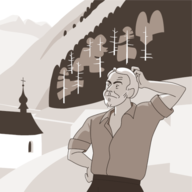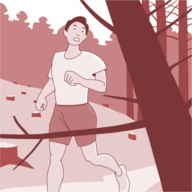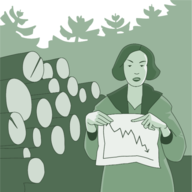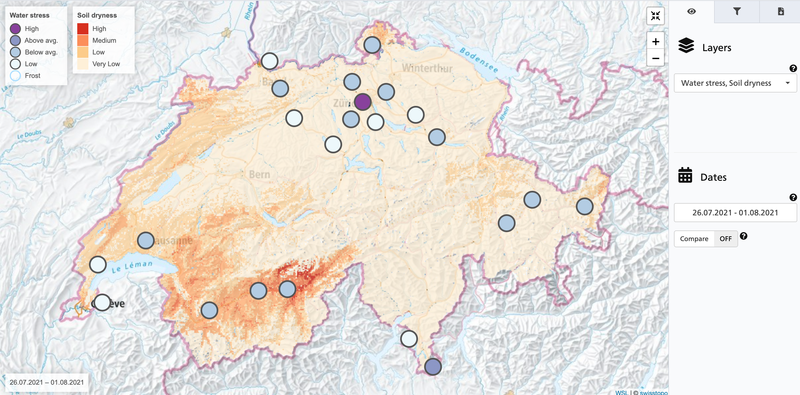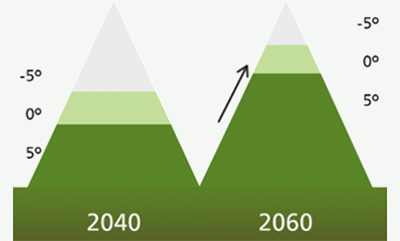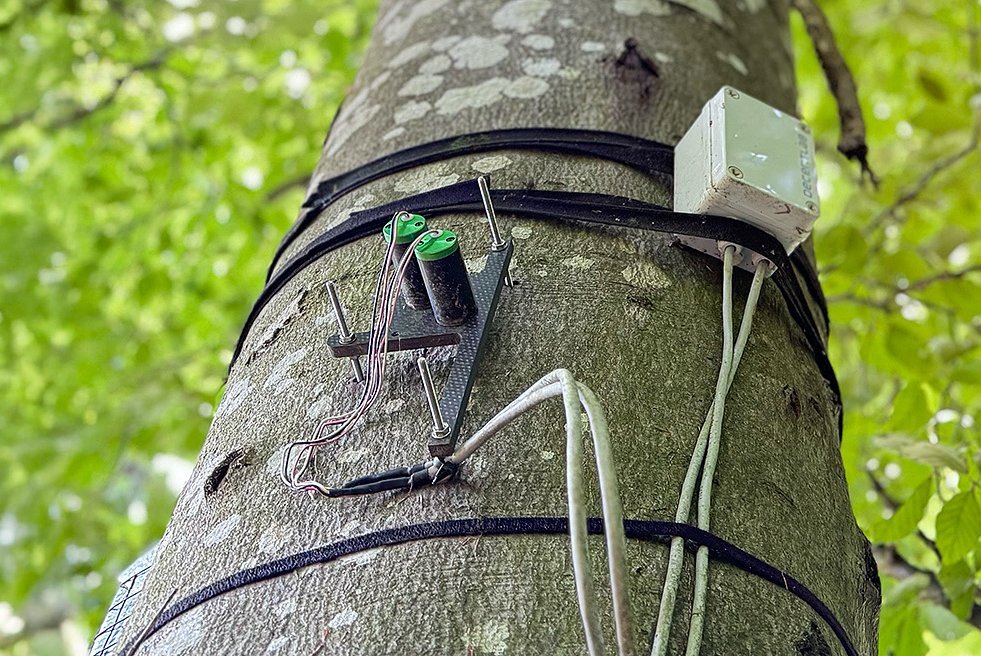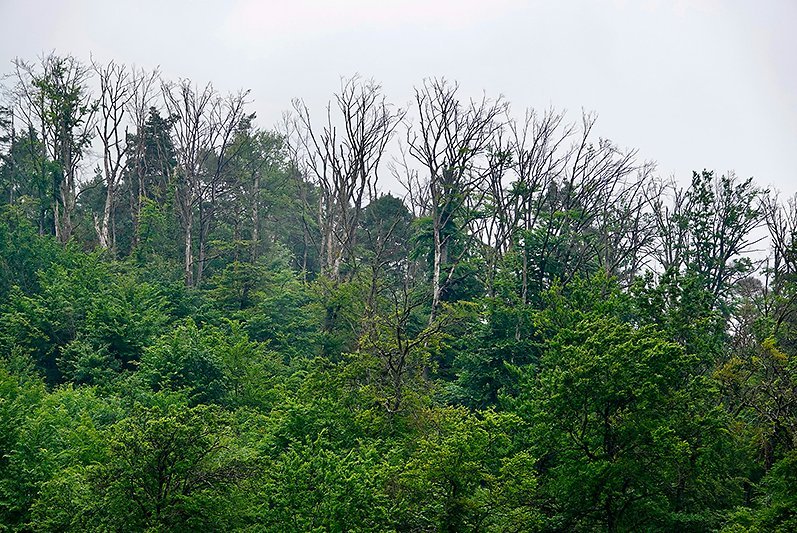In recent years, the need for reliable information on the current state of forests and possible future developments has grown in Switzerland. The Swiss Federal Institute for Forest, Snow and Landscape Research (WSL) meets this need with data collected or modelled at various temporal and spatial scales - from tree stem growth measured every 10 minutes to regional crown moisture derived from satellite data. A new thematic website on forest functions and climate change by the Swiss National Center for Climate Services (NCCS) explains the consequences of climate change on forests and their functions. Two apps are at the centre of the website. In addition, the NCCS website uses fictional narratives to convey four key messages about forests and climate change (Fig. 1).
Fig. 1. Key statements on climate change and forests: The impacts of climate change on the functions and ecosystem services of forests are presented on the basis of three personalised stories. From a fourth perspective, research approaches are explained that can make forests more climate-friendly in the future.
Forest functions and climate change
Climate change is particularly affecting forests around the world (Allen et al., 2010), leading to increased tree mortality (Hartmann et al., 2018) and thus threatening key forest functions. The loss of forest functions can limit the ecosystem services that forests provide to society. Forests produce wood but also regulate climate (Bonan, 2008), protect against natural hazards (Rigling & Schaffer, 2015) and provide recreation and habitat for plants, animals and people (Foley et al., 2005; Bell et al., 2009). A loss or even a reduction of the ecosystem services provided by our forests can thus lead to financial losses for forest owners, increased vulnerability of people and their infrastructures to natural hazards, and even feedbacks on the global climate.
With the help of two apps, both the current state of the Swiss forest (partly in real time) and its long-term developments can be displayed.
FORTE: current forest condition
The first app, called FORTE, makes it possible, for example, to display the current water stress of trees and combine it with information on soil dryness (Fig. 2). The effects of precipitation deficits can be visualised regionally and nationally, for example in hot dry summers as those that have occurred regularly in recent years. For this purpose, data from existing projects and programmes are combined. The current water stress of trees and their growth (Zweifel et al., 2021b) is recalculated daily as part of the TreeNet project, which uses data from point dendrometers, which measure the shrinkage and swelling of the trunk with high temporal resolution (Zweifel et al., 2021a). Soil dryness is recorded as part of the research projects for early detection of critical drought and low water in Switzerland (www.drought.ch). Another tree-related parameter that can be displayed with the new app is crown thinning, which indicates the general health of a tree (Dobbertin & Brang, 2001).
By clicking on the points representing several trees or stands in the overview, the values for stress, growth and crown defoliation can be displayed for individual trees. The data represent between 400 (growth, drought stress) and more than 1000 (crown defoliation) trees distributed over the whole of Switzerland. Other area-related data that can be displayed as background are the crown moisture derived from satellite data (Rigling et al., 2019), which is another parameter for the water stress of trees, and the number of generations of the box bark beetle, an important pest of spruce (modelled as part of the project Modelling the bark beetle risk): the more bark beetle generations occur in a year, the greater the risk of damage to spruce stands.
In the app, individual tree species can also be selected, different points in time can be displayed and years or points in time within a year can be compared in a split-screen mode. There are thus many ways for users to use the app to explore the current data on stress, growth and health of the Swiss forest in combination with drought or pest occurrence.
FORTE Future: future forest projections
The second app, FORTE Future, shows the principal habitat suitability for various tree species in Switzerland and thus their potential distribution in the present and in the medium or long-term future (Fig. 3 using spruce as an example). The potential distribution was modelled with the help of so-called Species Distribution Models (SDM) within the PORTREE project. The data on changes in climatic factors such as precipitation and temperature, which determine the distribution of tree species in the future, come from the EU project ENSEMBLES and were modelled according to the A1B emissions scenario (balanced use of different energy sources with rapid economic growth and introduction of new and efficient technologies).
In addition, the app displays the current temperature or precipitation distribution in Switzerland (for the whole year or specifically for winter, spring, summer or autumn), as well as the expected change in the future. Users of the app can thus visualise the current and future habitats suitable for the occurrence and growth of over 30 tree species and compare these with the climate changes. This clearly shows that there will be losers (such as the spruce shown in Figure 3) but also winners (e.g. sessile oak and English oak) with the higher temperatures and largely reduced summer precipitation predicted for the future.
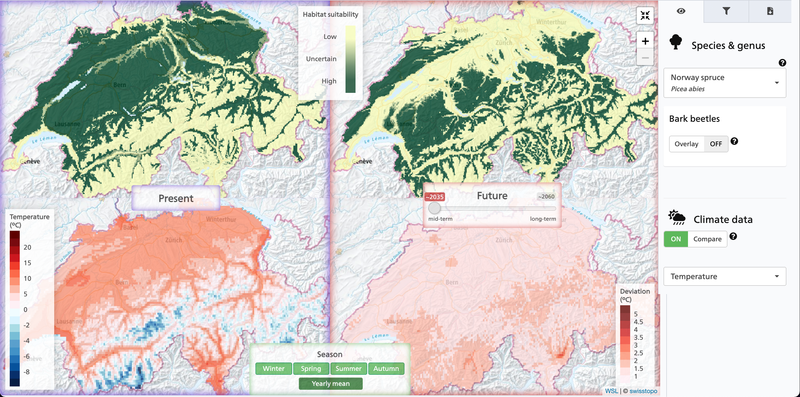
Fig. 3. Screenshot of the FORTE-Future app. On the top left, the current area suitable as habitat for spruce is shown. On the bottom left is the current average annual temperature (average of the years 1981-2010). The right-hand side shows the modelled distribution area of spruce for the future (top) and the annual temperature deviations (2060 compared to today; bottom).
FORTE Edu: For pupils
The FORTE Edu web app not only shows you colourful maps and information, but also requires your direct involvement. Together with forest ecologist Noemie, forester Jean and forest owner Flurina, you can answer exciting questions about climate change and forest health. Test your knowledge here yourself!
The most important facts in brief:
- Climate change is making it warmer and drier.
- A web app explains why the same tree species can no longer grow everywhere as they do today.
- With the help of various questions, you can test your knowledge directly yourself.
- The FORTE Edu app is part of the school programme for the exhibition "In the forest. A Cultural History" exhibition at the Swiss National Museum.
- FORTE Edu App
Additional information and download
For both apps, the displayed data can be saved and downloaded as a summary with additional accompanying information. The thematic website of the NCCS on the consequences of climate change on forest functions offers an entry point for interested citizens and is also intended to provide multipliers such as teachers and journalists with scientifically sound illustrative material. In addition, decision-makers in authorities and companies who have a connection to forests and forestry use are addressed.
National Centre for Climate Services (NCCS)
The Swiss National Centre for Climate Services (NCCS) is the network for climate services of the Swiss Confederation.
Climate services are scientifically-based information and data about the past, present and future climate and its impacts on the environment, industry and society. They are the bedrock of climate-compatible decisions at various levels of society. The NCCS website collects existing and newly developed climate services and places them in a scientific and societal context.
Literature cited
- Allen CD, Macalady AK, Chenchouni H, Bachelet D, McDowell N, Vennetier M, Kitzberger T, Rigling A, Breshears DD, Hogg EH, Gonzalez P, Fensham R, Zhang Z, Castro J, Demidova N, Lim J-H, Allard G, Running SW, Semerci A, Cobb N. 2010. A global overview of drought and heat-induced tree mortality reveals emerging climate change risks for forests. Forest Ecology And Management 259: 660-684.
- Bell S, Simpson M, Tyrväinen L, Sievänen T, Pröbstl U. 2009. European forest recreation and tourism: a handbook: Taylor & Francis.
- Bonan GB. 2008. Forests and Climate Change: Forcings, Feedbacks, and the Climate Benefits of Forests. Science 320: 1444-1449.
- Dobbertin M, Brang P. 2001. Crown defoliation improves tree mortality models. Forest Ecology and Management 141: 271-284.
- Foley JA, DeFries R, Asner GP, Barford C, Bonan G, Carpenter SR, Chapin FS, Coe MT, Daily GC, Gibbs HK, Helkowski JH, Holloway T, Howard EA, Kucharik CJ, Monfreda C, Patz JA, Prentice IC, Ramankutty N, Snyder PK. 2005. Global Consequences of Land Use. Science 309: 570-574.
- Hartmann H, Moura CF, Anderegg WRL, Ruehr NK, Salmon Y, Allen CD, Arndt SK, Breshears DD, Davi H, Galbraith D, Ruthrof KX, Wunder J, Adams HD, Bloemen J, Cailleret M, Cobb R, Gessler A, Grams TEE, Jansen S, Kautz M, Lloret F, O'Brien M. 2018. Research frontiers for improving our understanding of drought‐induced tree and forest mortality. New Phytologist 218: 15-28.
- Rigling A, Etzold S, Bebi P, Brang P, Ferretti M, Forrester D, Gärtner H, Gessler A, Ginzler C, Moser B, Schaub M, Stroheker S, Trotsiuk V, Walthert L, Zweifel R, Wohlgemuth T. 2019. Wie viel Trockenheit ertragen unsere Wälder? Lehren aus extremen Trockenjahren. Forum für Wissen: 39-51.
- Rigling A, Schaffer H. P. (Eds.). (2015). Forest report 2015. Condition and use of Swiss forests, Federal Office for the Environment, Bern, Swiss Federal Institute WSL, Birmensdorf. 144 p.
- Zweifel R, Etzold S, Basler D, Bischoff R, Braun S, Buchmann N, Conedera M, Fonti P, Gessler A, Haeni M, Hoch G, Kahmen A, Köchli R, Maeder M, Nievergelt D, Peter M, Peters RL, Schaub M, Trotsiuk V, Walthert L, Wilhelm M, Eugster W. 2021a. TreeNet–The Biological Drought and Growth Indicator Network. Frontiers in Forests and Global Change 4.
- Zweifel R, Sterck F, Braun S, Buchmann N, Eugster W, Gessler A, Haeni M, Peters RL, Walthert L, Wilhelm M, Ziemińska K, Etzold S. 2021b. Why trees grow at night. New Phytologist 231: 2174–2185.

